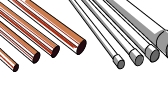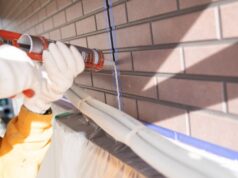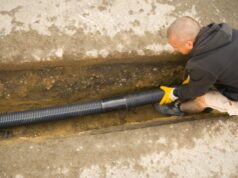
Find out what the difference is between pipes and tubes, what kinds are used for what purposes, and what sorts of pipes and tubes will be used in your home.

Your plumbing system is essentially a branch network of pipes and fittings. All your gas and water needs are supplied via the piping system within and outside of your home. Pipes also remove waste in the form of sewage and waste-water, and allow sewer gases to be vented to the outdoors. Pipes also deliver the potable (drink quality) water to your home for you to drink, and for bathing. They also serve hydronic and in-floor heating systems. In more recent time they have also distributed recycled water for uses such as toilet flushing.
What are plumbing pipes made from?
The pipes used in your home’s plumbing can be made from various materials. Copper, cast iron and galvanised pipes were once the mainstay of the plumbing system; however the advent of ‘plastics’ technology has seen a major shift in the materials that plumbing pipes are made from. Plastic pipes are light-weight, they don’t corrode like metal pipes do, and they’re easy to connect together.
- Here’s a good reason not to play with a piping system yourself. If a metallic pipe is being replaced or installed, in part, or in its entirety by a plastic pipe or any other non-metallic fitting or coupling, your plumber needs to follow a strict safety procedure. No work should be carried out until the earth requirements have been checked out by an electrical contractor and modified if necessary. Electrocution from un-earthed plumbing systems has killed and injured many a plumber and householder!
What is your choice in pipes?
The following types of pipes are available for various systems in your house. If you’re interested in the type being used, ask your plumber which best suits your requirement. He or she should have local knowledge about soil conditions and water quality, both of which can have an effect on certain piping materials.
Copper pipe systems
Copper plumbing systems have historically been the most commonly used in Australia. Many of these systems are now approaching 60 years old, and most show little sign of ageing. Copper resists corrosion very well, and is ideal for carrying both hot and cold water, as well as gas. Up until recently, copper pipes were connected with soldered fittings. These days, new push-fit/crimp connections are available, which significantly reduce the installation time.
Copper pipe systems generally need fewer fasteners (than most alternative materials) to connect the pipes to wall studs, and are relatively easy to install through narrow wall and floor spaces. It’s important that they’re properly clipped to the wall studs, as being a rigid material, water hammer can reverberate through the system.
Copper plumbing offers a safe and clean water supply, and the material’s properties offer a natural defence against dangerous bacteria growth. When used below ground without a protective layer though (normally a plastic), copper pipes can be sybject to electrolysis attach, which leads to failure.
Copper sold in Australia should be produced to a strict quality to meet Australian/New Zealand Standards. Make sure your plumber uses copper that is produced locally, as finding out later that it’s a poor quality imported substitute which doesn’t meet the performance standards can be very costly to repair or replace.
- In some rare instances where ground water is the source of supply, copper pipes may on occasion develop a green taint to the water coming through the outlet – so consult your plumber and local water authority if you happen to be using ground water.
Plastic pipe systems
Plastic pipes come in many different compositions. They are lightweight, chemically resistant (some more so than others), non-corrosive and easy to connect. It’s important that your plumber is aware of the water pressure on your property, as plastic pipes are also rated to various pressure and temperature limitations.
When connecting plastic pipes, particularly for renovations or repairs, your plumber should use an identical brand of fitting to the one being replaced, so as to ensure compatibility. With new installations, your manufacturer’s warranty will be voided if your plumber has used fittings from another brand. For repairs where an original brand of fitting is not available, your plumber will be able to source an approved transition fitting.
When clipping a plastic pipe system to the wall frame/stud, metallic clips should not be used.
Some of the more popular plastic materials used in a range of applications in houses are:
- PVC (polyvinyl chloride) – Used is for carrying waste from basin outlets, sinks and toilets to the main connections at the property boundary. It is also used for conveying rainwater from the roof to a rainwater storage tank or directly to the underground drainage system.
- CPVC (chlorinated polyvinyl chloride) – Used for hot and cold water, CPVC has become popular as a pipe for distributing domestic sprinkler systems within homes. It is flexible and light in weight and doesn’t support combustion.
- PEX (cross-linked polyethylene) or PB (polybutylene) – These two popular materials can be used to carry both cold and hot water. Primarily used for interior plumbing in residential settings, they are very flexible and light-weight but must be protected when installed underground – although if quality brass fittings are used, they generally don’t need protection. PEX or PB piping must not be in a position that exposes it to UV rays, though some PEX pipe now meets the full requirement for UV stability. Make sure your plumber checks this with his supplier – remember that old saying…oils ain’t oils.
- Composite/multi-layer – these materials are composed of layers of material with unique properties. The inner and outer layer is made from high-density polyethylene and sandwiched between is a layer of aluminium. Initially used for hot and cold water installation, composite pipe is now also used for gas reticulation. One cautionary note with using composite pipe for gas reticulation is to observe the material’s temperature limits. For example, depending on the composite make-up, it may not be recommended that a gas pipe is run across a sun-exposed metal roof. Make sure your plumber doesn’t cut corners (literally).
- It’s vital that your plumber installs copper piping for the first metre (or to the manufacturer’s recommendation) leading from any heating source, such as a hot water storage tank / instantaneous hot water unit or a solar panel installation. It can then be joined to the selected plastic pipe system once the heat is tempered over this short distance. This is a regulatory requirement, as water coming from a solar panel system can be well above boiling point, and if a heat control valve fails on your hot water unit at least your piping system is safeguarded! There are specific valves available to ensure the temperature/pressure limitations are not exceeded, even in some solar applications.
Galvanised pipes
Galvanised (gal) pipes were commonly used in Australian home construction until the 1950/60’s. They are steel pipes covered with a layer of zinc, which is there to prevent corrosion and increase the pipe’s lifespan. Galvanised pipes were used for both cold and in some instances hot plumbing applications. The material can react to minerals present in the water, producing scale/corrosion and leading to lower water pressure, which obviously shortens the working life of these sorts of pipes. You won’t see galvanised pipes being installed in new houses these days.
Cast iron pipes
Cast iron piping is more resistant to corrosion than gal, due to its internal/external coating.
Though it is not used for piping all that frequently today, cast iron is most likely to be found in multi-unit developments and large homes where pipes run through common areas of a building. This is because its inherent acoustic characteristics help to reduce noise transmission into adjacent rooms or apartments.
Vitrified clay
In many older homes you may find ‘clay’ pipes which were used for underground drainage systems (sewerage, waste & stormwater). If these systems need to be added to when a renovation is being done, the plumber is more likely to use a PVC pipe to extend from the clay pipe to the new fixtures. Clay pipe and fittings can still be purchased if they are required though.
- Here’s something to sleep on – make sure your plumber or architect designs your pipe network so that it doesn’t require installation of any plumbing services in the walls of a bedroom or other sensitive rooms. Where this is unavoidable, special acoustic insulation will be required. This needs to be properly considered before installation.





